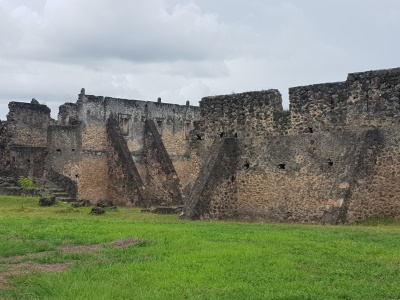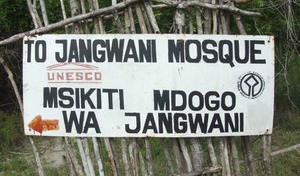Ruins of Kilwa Kisiwani and Songo Mnara

The Ruins of Kilwa Kisiwani and Songo Mnara comprise two ports that had an important position in East African trade between the 13th and 16th centuries.
Trade with Arabia, India and China was mainly in gold and iron from Zimbabwe, ivory and slaves from Tanzania, and textiles, jewellery, porcelain, and spices from Asia. The influence of its Swahili culture reached far. From this period date the construction of the Palace of Husuni Kubwa and a significant extension to the Great Mosque of Kilwa, the oldest standing mosque on the East African coast.
Community Perspective: Atmospheric and in good condition. The sites each lie on an island and are accessible by cruise ship or by dhow transfer from Kilwa Masoko (Songo Mnara is the furthest of the two, and the trip to get there takes about 1.5h).

Map of Ruins of Kilwa Kisiwani and Songo Mnara
Community Reviews
Geert Luiken
Recently I visited both Kilwa Kisiwani and Songo Mnara. As the former is already covered in many reviews I will focus om the later. Through Elisabeth, the owner of the highly recommended Kimbilio lodge in Kilwa Masoko we got into contact with Osman, a very enthousiastic and knowledgable guide. The boat trip from Kilwa Masoko to Songo Mnara takes about 1,5 hour. You arrive at a rather primitive settlement of local fishermen and after passing through some mangrove forest on foot you reach the ruïnes of the former palace dating from 11 th century. Big baobab trees have partly taken over the buildings, but there is still quite a lot to see. The site was very quiet, our group of 3 had the place to ourselves, as was also the case when we visited Kilwa Kisiwani the next day. On the way back we did some great snorkelling. It was a great trip and the ruins were quite interesting.
Svein Elias

For our (European) summer holiday 2022 we aimed for three African countries and the first site we visited was the ruins of Kilwa Kisiwani. Our flight had its final stop early morning in Dar es Salam, and we spent the day at our travel agent’s premises at Kawe beach.
The following morning, we started our first roundtrip with a 4x4 safari vehicle and a driver/guide. Such a vehicle (and a driver) is not necessary for this stretch, but as we had safari plans on the roundtrip it was convenient. The drive south to Kilwa Masoko is 5-6 hours including a short meal stop. It was uneventful, but African driving is potholes, road work and the locals sharing the road.
Arriving at Kilwa Masoko around 1:30 we had the rest of the day off. We stayed at Kimbilio Lodge which is right on the beach (10 m from the water), a place with our own little cabin and the view from our bed out the door was the ocean, the sandy beach, and a parasol (made of grass and wood), simply iconic. Beeing the only guests made it even more special as we got personel service all the way, but from August their "books where full" again.
The following day we headed to the site itself, Kilwa Kisiwani. Our driver/guide took us to the harbour where we registered and picked up the local guide. When entering the boat, we were told the voyage across started with a small sightseeing looking at the coral reef through the glass bottom, but due to uneasy sea, it didn’t turn out very well, so we headed to the island.
The previous reviewers have revealed the most interesting details of the site, but i'd like to add that it’s a treat being guided on these precious premises with its history starting from the 8th or 9th century and ruins from the 11th to the 16th century even though it’s quite a hike. Late June is a perfect time for this visit, not too hot. We disembarked on to a stone jetty with ease. We passed by the upcoming visitor center and then to the first ruins. We visited a village with locals and had a brief stop at “someone premises”, very interesting. The most remarkable structure is the octagonal sultan's pool in his palace area (picture). Slaves had to fill it manually. When leaving the island we waded to the boat at the foot of the enormous sultan’s palace.
We didn't visit the other island Songo Mnara. I guess it would have been possible, even on the same day, but we hadn't prearranged that. The guide also mentioned another site, Kilwa Kivinje, which he ment was also would be an interesting one.
Around 2:00 we were back at our lodge having some more leisure time and the next day we went on to the next WHS.
Wojciech Fedoruk

From the two inscribed locations, I only saw Kilwa Kisiwani. Kilwa Kisiwani is a vast ruin of the city which has been an important political and trade center from around the 8th century AD and since the 10th century the capital of the Sultanate of Kilwa. According to legend, the sultanate was founded by the rulers of Shiraz and, although historical sources do not currently confirm this thesis, it seems to be considered true among locals - the guide told me the same.
Regardless of the origin of the founders, the continuation of Kilwa Kisiwani's history is better documented. The Sultanate of Kilwa existed until the beginning of the 16th century. Its fall occurred with the arrival of the Portuguese, who, however, quickly gave way to the Omani.
All these rulers have left magnificent buildings in Kilwa Kisiwani. I started my trip from the Husuni Kubwa Palace, the spectacular ruins of the Sultan's Palace from the 14th century, i.e. from the times of the Kilwa Sultanate. The ruins are very well preserved and give a good idea of how powerful this kingdom was - the palace is really spacious and equipped with many novelties, such as the first (at least according to the guide) swimming pool in Africa. From the 14th-century well dug by the slaves of the Sultan the inhabitants of the surrounding village still draw water - I saw it with my own eyes!
Husuni Kubwa Palace is about a kilometer to the remaining ruins and a 15-20 minute walk among rural buildings. Walking in the heat and in high humidity is not the most pleasant, although watching the local life partially rewards it. The largest group of ruins is located in the northwestern tip of the island. I started my tour from the old cemetery of the Sultan and his family, and then went to the most spectacular part of the ruins of Makutani Palace (a magnificent palace from Omani period) and the Great Mosque - the first congregational mosque in Sub-Saharan Africa. The last building visited was a well-preserved fort (see photo) - built by the Portuguese during their short reign on the island, but enlarged and improved by the Omani.
Overall, the ruins are in good condition, the maintenance is ongoing, and there seems to be no reason to consider Kilwa Kisiwani as World Heritage in Danger (it was removed from that list in 2014). The sheer volume of buildings that remain gives a good idea of how powerful Kilwa once was. A definitely well-deserved inscription and one of the most interesting places on the Tanzanian UNESCO list. For me, a great start of 2021 (I visited the ruins exactly on New Year's Day).
I reached Kilwa Masoko from Selous Game Reserve. The journey takes about three hours, on a terrible road that can only be traveled safely by motorbike or off-road jeep. The advantage of driving these bumps was the possibility of observing real life in the Tanzanian countryside. I went back directly to Dar es Salaam and the journey took about five and a half hours. My trip to Kilwa Masoko was pre-arranged by the safari company, but you can arrange everything on the spot. Buses run from Dar es Salaam and the visitor center with guides is 300 m from the port where dhows depart to the Kilwa Kisiwani ruins. If anyone is interested, I provide information on a local guide with whom everything can be arranged directly - Saidi, tel / whatsapp +255682717141. Note, it's better to have shorts with you, because at Husuni Kubwa Palace you disembark straight into the shallow water!
Kilwa Masoko is a quite popular city with decent hotel base. I had the pleasure of living in a house 100 meters from the beach, watching hundreds of people walking on the beach and celebrating the New Year.
If someone is interested in visiting Songo Mnara, it can also be arranged in Kilwa Masoko, but due to the distance, you need to book at least half a day for it. The visit to Kilwa Kisiwani took me about 2-3 hours.
Maimuna Kubegeya, A journalist
November 12nd,2013 was my lucky day! For the first time i visited Kilwa Kisiwani
It is so excited place i have never seen in my life. It took me few minutes to reach the place from Kilwa masoko.
My first place to reach were Makutani palace, where there is a large walls then i went straight to Small Domed Mosque before going to great Mosque where sultane Al Hassan Bin Sulaiman used to pray.
From there i went to Gereza the Kilwa's fort which historically built by Portuguese. Then i went direct to Malindi Mosque also i visited Malindi graves where the Malindi People from Kenya buried over there. My last visit were to Hussuni Kubwa, the largest building in southern Sahara by the time of 13th to 14th century.
I real enjoy the place.
Solivagant

My favourite cultural WHS are those which give new and unexpected insights into a civilisation or a period of history. The ruins of Kilwa Kisiwani certainly did that for me by providing an entrée to the world of the Indian Ocean before the arrival of the Europeans (as well as to the impact of their arrival!). Pre-colonial Africa may still be seen as the “dark continent” in euro-centric minds but its east coast played a full part in this ocean’s multi continental trading system. At Kilwa you may get a feeling for the sophistication of what could be characterised as the “Swahili civilisation” between the 11th and 16th centuries and Kilwa was a major centre for the development of that civilization based on influences from Africa, Arabia, Persia and India.
Today this island off the Tanzanian coast contains just a sleepy village of around 800 inhabitants engaged in fishing and rudimentary agriculture. But, as you walk the quiet paths, you come across the ruins of palaces, great houses, trading courtyards, forts, mosques and tombs. Despite ups and downs in prosperity, this island was the location of a great trading city for around 700 years, reaching its peak between the 12th and early 14th centuries. Its particular “edge” over other east coast ports lay in its position at the terminus of routes into interior Africa and, in particular, to Great Zimbabwe. From here came gold which was distributed around Eurasia – indeed one period of decline was associated with the 1340’s Black Death in Europe which reduced the metal’s word-wide price. The wealthy of Kilwa could afford luxuries from across the “known world” and, among excavated remains, was 14th century pottery from China. When the Portuguese arrived in 1498 they compared what they saw favourably with their own houses and goods.
The site was comprehensively excavated in the 1960s under the management of an Englishman, Neville Chittick. If you also visit Dar Es Salaam, you should go to the National Museum where some of the finds are on display and there are good explanations of the worldwide trading system, of the various ruling dynasties and of the periods of prosperity and decline experienced by the town. “WHS” enthusiasts might enjoy noting the “trading links” connecting a wide variety of apparently disparate sites such as Zimbabwe, Oman’s Khor Rori (“Land of Frankincense”), the Renaissance cities of Italy with their appetite for gold at that time unsatisfied from the Americas and even Baltic Visby (via the Volga!) – as early as the 13th century the world could be a small place! Some of Chittick’s conclusions about Kilwa’s history represented in the museum’s rather ageing display are not regarded as acceptable by today’s historians who want to emphasise indigenous as opposed to imported influences (even if these might have come from Asia rather than Europe!). The Aluka Web site provides a great resource on Kilwa and some of these revised interpretations. It is also is a good place generally to find out more about African history (including a section on “African Cultural Heritage Sites and Landscapes”)
Some of the ruins are little more than the foundations of buildings with walls of coral rock limited now to a meter high or less but others have largely complete walls and a number, particularly the main mosque, even still have partial roofs. This mosque (photo) contains an original prayer hall from the 11th century and, with extensions, was the largest mosque south of the Sahara before the 16th century. Some buildings, like the fort (“Gereza”), were originally built by the Portuguese who ruled in the 16th and 17th centuries and others like the Makutani Palace date to the 18th century when the rulers were Omani. The real gem is the 14th century Husuni Kubwa Palace (when the rulers came from the Yemen) but this unfortunately is situated a kilometre or so east of the main remains and needs more time to explore than I really had.
We arrived by sea on a “cruise” vessel and only had a short afternoon at the site. Given the difficulties in reaching Kilwa Kiiwani by other means (you will probably need to take a dhow from Kilwa Kisoko on the mainland and we saw locals unloading in knee deep water from such craft!!) - I would certainly plan to spend a full day or even an overnight (there is some accommodation on the island and such a stay might enable you to reach the second part of the Inscription at Songa Mnara on an adjacent island to the south). The island is delightfully peaceful to wander around with some fine seascapes and offers good nature walks among a variety of habitats for birds etc to complement the ruins. The people are friendly but little English is spoken although we met many students of the island’s Islamic school scattered in the ruins or under trees learning the Koran! Try also to get hold of the book “Kilwa Kisiwani – Ancient Port City of the East African coast” by Karen Moon (ISBN 9987 440 01 0). This beautifully prepared 68 page book is a real “labour of love” given the relatively few tourists who will reach the site. This was available for us “cruisers” on the quay side but you may have to get it in Kilwa Kisoko where, I understand, you have to visit the local government offices to pay your entrance if you are not part of a group. As it is published by the Tanzanian Ministry of Resources and Tourism (with help from the French government) it is probably also available in Dar although I didn’t see it at the National Museum. If you can’t get it, the site is still remarkably well signed via notice boards containing comprehensive descriptions of each building in English (and Swahili!).
In conclusion – Kilwa Kisiwani is an atmospheric place well worth a bit of effort to reach. “Old” towns of the East African coast are well represented on the UNESCO list (Lamu, Zanzibar and Ihla do Mocambique) but ruined Kilwa provides a different dimension. In much the same way as Leon Viejo and Portobelo got me closer to the early colonial days of the Americas than other more touristy colonial towns with later “modern” accretions so I felt that Kilwa achieved the same for its area of the world and timeframe.
Site Info
- Full Name
- Ruins of Kilwa Kisiwani and Songo Mnara
- Unesco ID
- 144
- Country
- Tanzania
- Inscribed
- 1981
- Type
- Cultural
- Criteria
-
3
- Categories
- Archaeological site - Civilizations of Sub-Saharan Africa
- Link
- By ID
Site History
2014 Removed from Danger list
2004 In Danger
Continuing deterioration and serious threats
1981 Inscribed
Site Links
Unesco Website
Official Website
Related
Connections
The site has 28 connections
Art and Architecture
Constructions
Geography
History
Human Activity
Individual People
Religion and Belief
Timeline
Trivia
Visiting conditions
WHS Names
WHS on Other Lists
World Heritage Process
Visitors
30 Community Members have visited.
